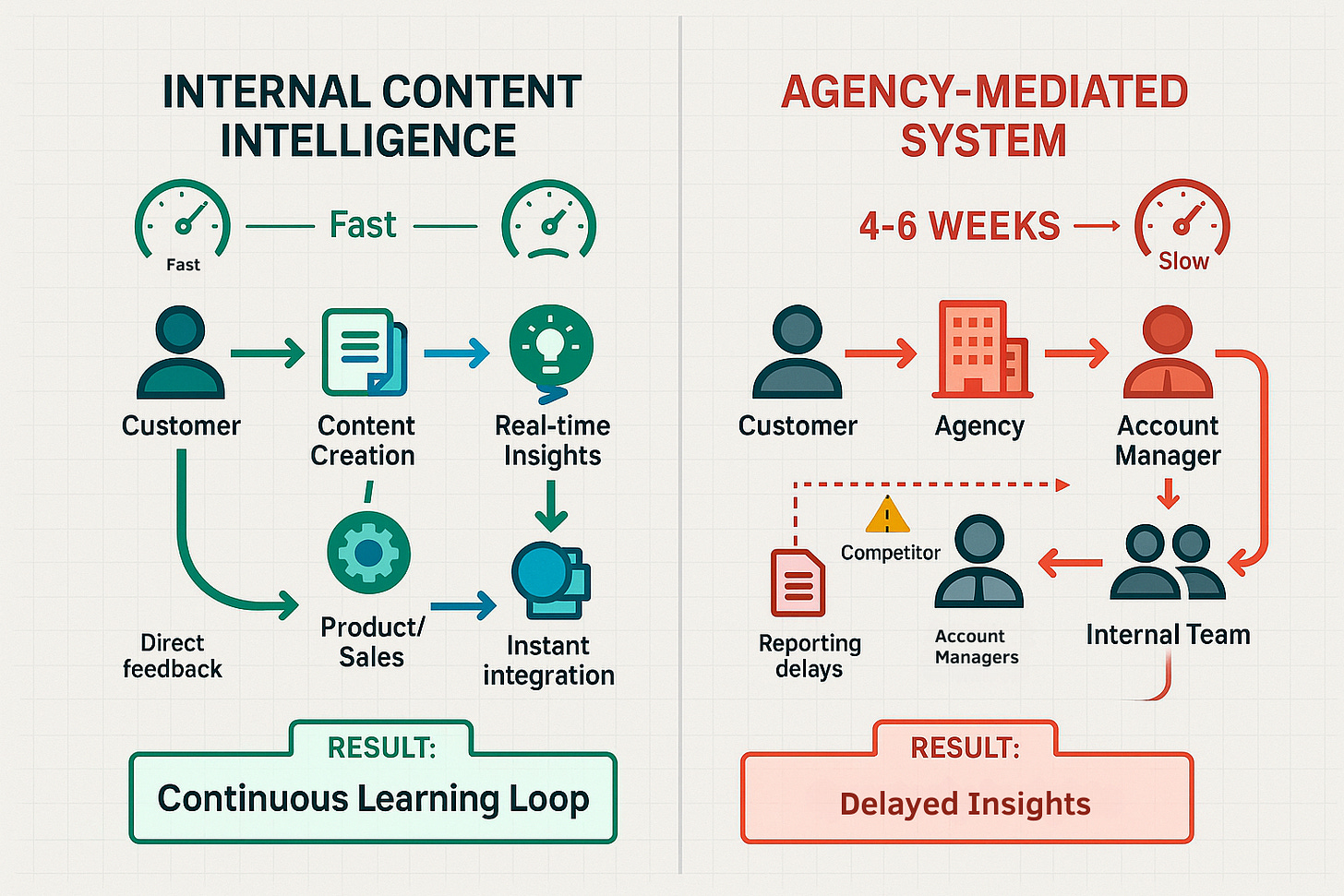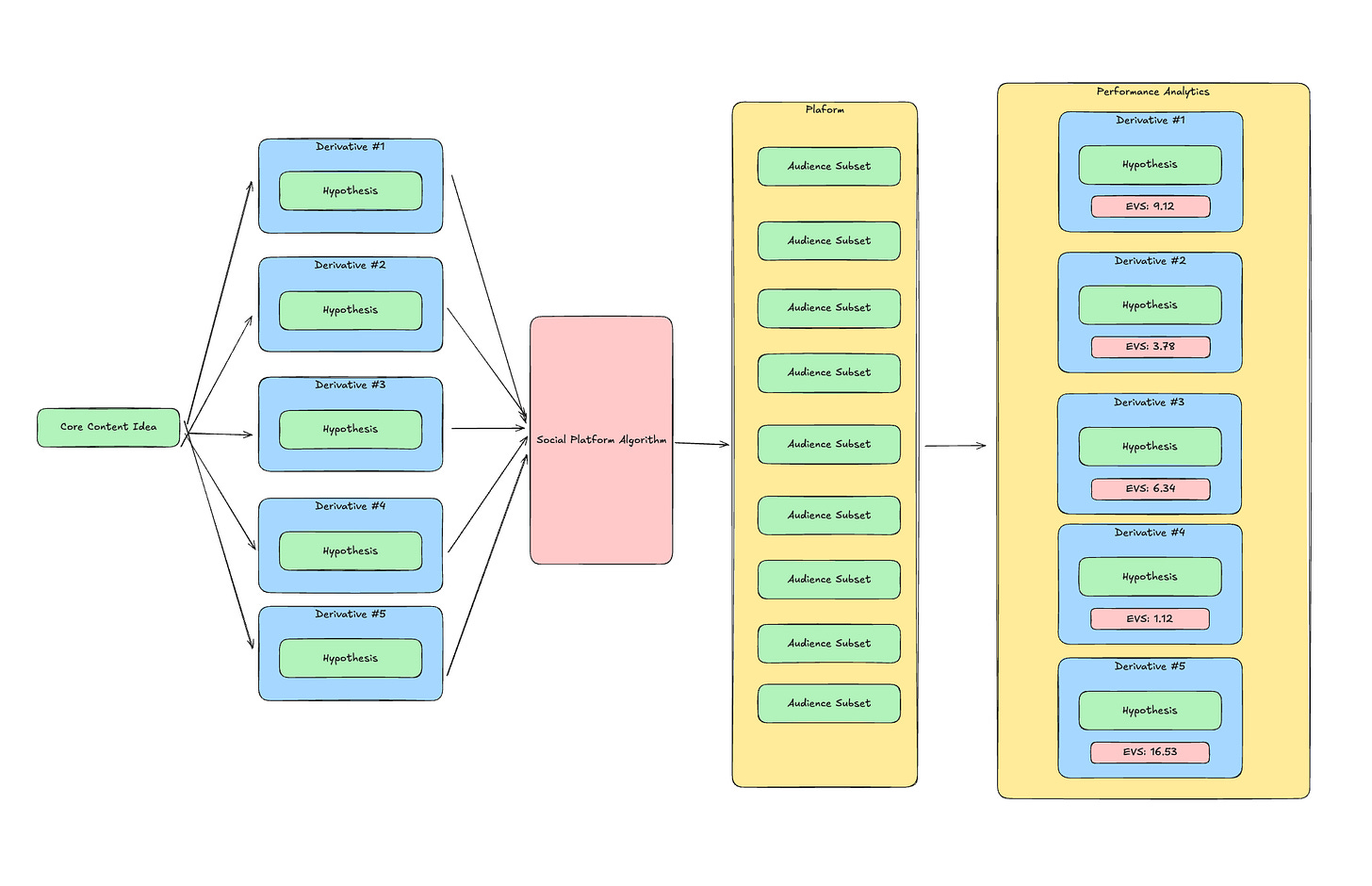Why Content Is Your Startup's Secret Intelligence Weapon
Ditch $50K reports—build AI systems that extract buyer psychology from experiments and deliver pivots in days, giving you the learning speed agencies can't match.
Three months ago, I was sitting in a coffee shop in Shoreditch with a founder who had just burned through £50,000 on a marketing agency. His startup was bleeding cash, and he'd paid an expensive team to guess what his customers wanted.
"They gave us beautiful reports," he said, stirring his oat milk cortado with visible frustration. "Charts, graphs, quarterly insights. But by the time we got the 'insights,' our competitors had already shifted the market."
That conversation kept me up for weeks. Here's what I realised: Your startup is fundamentally an information-processing machine. The company that learns fastest doesn't just win—they rewrite the rules entirely.
And most founders are outsourcing their primary learning mechanism to agencies that are optimising for the wrong metrics.
How Stripe Won the Intelligence War
Everyone thinks Stripe beat PayPal because of better technology. That's not the real story.
The real story is about information asymmetry.
While PayPal optimised for CFO approval processes and enterprise sales cycles, Stripe discovered something crucial through direct market engagement: developers were the actual gatekeepers of payment adoption decisions.
Patrick Collison, being a developer himself, understood this viscerally. As he later explained: "Every time I built a project, I'd either skip payments integration... because it seemed like so much work."
This wasn't market research. This was a lived experience that informed product strategy.
That single insight—that developers were actively avoiding payment integration due to complexity—became the foundation for a $95 billion company.
Speed of learning equals speed of winning. Companies that process market signals faster don't just compete better—they operate in an entirely different competitive reality.
But here's the problem with traditional startup "research": You don't have quarterly surveys or annual market reports. You have customer interviews that are challenging to obtain, time-consuming and costly, and often don't scale beyond initial product validation.
Meanwhile, your competitors are building continuous conversation systems with their markets. Through content. Through community engagement. Through direct, scalable customer discovery.
And they're doing it in-house.
Content as Market Intelligence: A Personal Discovery
I learned this lesson the hard way with my previous startup.
We hired a digital marketing agency after reading all the right growth blogs. They promised "brand awareness" and "thought leadership." What we got were beautiful posts that generated zero actionable insights about our customers.
Three weeks in, our team decided to pull the plug. Not because the content was bad—it was professionally crafted. But we were optimising for the wrong outcome. We assessed the impact of our content based on impressions, rather than learnings. That was a mistake.
The real value of content isn't impressions. It's intelligence.
Every piece of content is actually a market research experiment. When prospects spend three minutes reading your technical deep-dive but scroll past your product announcements in five seconds, you've just learned something worth £50,000 in traditional market research.
Here's what most founders miss: Consuming content and making purchasing decisions use the same cognitive process. Both require investing a scarce resource—attention. This means engagement patterns reveal buying psychology with surgical precision.
Think about it. When someone chooses to engage with your content about implementation guides versus feature comparisons, they're telling you exactly how they evaluate solutions in your space.
The Algorithm Advantage
Social platforms have created the world's most sophisticated market research infrastructure.
Platforms like TikTok optimise for engagement to drive advertising revenue. Their incentive for keeping people hooked aligns perfectly with your need for market intelligence about what actually resonates with your audience.
What people engage with reveals their true priorities, not what they claim in surveys.
The TikTok algorithm changed everything. Content algorithms now identify content-market fit 24/7 using AI systems more sophisticated than anything you could ever afford. You create content with hypotheses about what might resonate. The algorithm tests it across micro-segments of your target market and gives you precise feedback.
This creates 24-hour hypothesis testing cycles instead of quarterly research reports.
Does your audience respond better to efficiency messaging or productivity messaging? Test it on Tuesday morning. Know the answer by Wednesday lunch. Implement across your entire go-to-market by Thursday.
Why Outsourcing Is Strategic Suicide
Here's what keeps me up at night about agencies: They're learning about your customers, your market, and your messaging effectiveness. Then they're taking those insights to your competitor's pitch meeting next month.
When you outsource content creation, you outsource your primary learning mechanism.
I see founders who understand this intuitively but struggle with the practical implementation. They recognize that content creates valuable market intelligence, but they become overwhelmed by the perceived complexity of "content marketing."
Let me tell you about Cluely. They took this intelligence-gathering approach to an extreme. They hired 50 content creator interns, churning out content across 40 different accounts every day. Non-stop.
Their goal? Identify what goes viral and resonates with their audience. They analyze highly engaging content and use those insights to inform product decisions.
Cluely will win because they're distribution-first with a content intelligence system at its core. As the video shows, they use interns, but you can just as well use AI-optimised content-generating agents for a fraction of the cost.
Integration friction kills competitive advantage. When your agency discovers shifting customer priorities, that intelligence gets filtered through account managers, reporting cycles, and monthly check-ins. By the time insights reach your product team, competitors operating with internal intelligence systems have already adapted.
Remember: Every "failed" post becomes valuable data about your audience when you're optimizing for learning instead of vanity metrics.
Building Your Internal Intelligence Advantage
Last week, while reviewing our content performance for a Nordic client, I noticed something interesting. Posts about "efficiency" were receiving three times more engagement than posts about "growth."
Within 48 hours, we'd updated their product messaging, email sequences, sales conversations, and even the copy on their landing page.
Try achieving that level of intelligence integration speed through an agency relationship.
Your daily business operations create content gold. The question I get from founders constantly is: "What should I talk about?"
The answer is staring you in the face: Your business operations are the exact source of content ideas you need.
Customer support conversations reveal pain points worth addressing. Sales objection patterns shape messaging frameworks. Product usage data guides content distribution strategies. The conversations you have with customers every day are filled with insights that your competitors would pay thousands to discover, and these insights can very well resonate with your audience.
You need a low-friction system to capture and transform these operational insights into content experiments. That should be a key design feature of any content intelligence system you adopt.
The Mathematical Reality
Your three main competitors are building internal content capabilities that provide real-time market intelligence. Your agency partnership—regardless of quality—is now a structural disadvantage.
Mathematical reality: If your competitors have faster learning cycles, deeper customer insights, and integrated decision-making processes, your external partnership creates systematic delays that compound into competitive gaps.
Here's a scenario that plays out every week: Your competitor's internal team discovers that technical buyers prefer implementation guides over feature comparisons. How do they know? They tested both content approaches across different formats and platforms. Implementation guides got 5x more engagement.
They immediately adjust content creation, update email sequences, inform sales messaging, and redesign product positioning. Conversions increase, sales increase.
You’re left behind while waiting for your agency's monthly performance report.
Market intelligence compounds through internal teams in ways that external partnerships cannot replicate. Your internal content team understands customer development cycles, competitive dynamics, and the challenges of product positioning. They build relationships across your organization that amplify insights across every business function.
The companies building internal capabilities now will have insurmountable intelligence advantages by Q3.
What This Means for You
I work from the Entrepreneur First office here in London, and I've had this exact conversation with hundreds of startup founders over the past few months.
The constraint isn't understanding the value of the content. It's a practical day-to-day implementation.
How do you consistently create content that generates actionable insights about your market? How do you build systems that capture operational learnings and transform them into intelligence-gathering experiments?
Today's opportunity is unprecedented. Platforms like N8N and Make, combined with the collapsing cost of AI reasoning models, create a golden opportunity to bring sophisticated content intelligence systems in-house.
AI, with the right prompts and frameworks, can create better hooks and copy at scale. This scale allows you to test hypotheses across multiple customer segments and emotional triggers, maximizing learning opportunities from every piece of content you create.
My company partners with businesses to develop precisely these kinds of in-house content intelligence strategies. I'm completely transparent about our process—sharing insights, workflows, successes, and failures as we build them.
I provide the actual AI prompts, automation workflows, and analytical frameworks we use—a full build-in-public approach.
Because while your competitors are guessing, you should be learning.
Want the practical implementation frameworks? The systems, workflows, and AI tools that transform content creation into competitive intelligence gathering?
Follow along as we build these systems in the open. Because the companies that treat content as intelligence gathering—not just marketing—will have sustainable competitive advantages that agencies cannot replicate.




